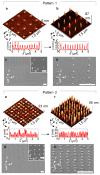Site-directed placement of three-dimensional DNA origami
- PMID: 37640908
- PMCID: PMC7616159
- DOI: 10.1038/s41565-023-01487-z
Site-directed placement of three-dimensional DNA origami
Abstract
The combination of lithographic methods with two-dimensional DNA origami self-assembly has led, among others, to the development of photonic crystal cavity arrays and the exploration of sensing nanoarrays where molecular devices are patterned on the sub-micrometre scale. Here we extend this concept to the third dimension by mounting three-dimensional DNA origami onto nanopatterned substrates, followed by silicification to provide hybrid DNA-silica structures exhibiting mechanical and chemical stability and achieving feature sizes in the sub-10-nm regime. Our versatile and scalable method relying on self-assembly at ambient temperatures offers the potential to three-dimensionally position any inorganic and organic components compatible with DNA origami nanoarchitecture, demonstrated here with gold nanoparticles. This way of nanotexturing could provide a route for the low-cost production of complex and three-dimensionally patterned surfaces and integrated devices designed on the molecular level and reaching macroscopic dimensions.
© 2023. The Author(s), under exclusive licence to Springer Nature Limited.
Conflict of interest statement
The authors declare no competing financial interest.
Figures





Similar articles
-
Templated assembly of DNA origami gold nanoparticle arrays on lithographically patterned surfaces.Methods Mol Biol. 2011;749:187-97. doi: 10.1007/978-1-61779-142-0_13. Methods Mol Biol. 2011. PMID: 21674373
-
Large-area spatially ordered arrays of gold nanoparticles directed by lithographically confined DNA origami.Nat Nanotechnol. 2010 Feb;5(2):121-6. doi: 10.1038/nnano.2009.450. Epub 2009 Dec 20. Nat Nanotechnol. 2010. PMID: 20023644
-
DNA Origami Structures Interfaced to Inorganic Nanodevices.Methods Mol Biol. 2018;1811:263-278. doi: 10.1007/978-1-4939-8582-1_18. Methods Mol Biol. 2018. PMID: 29926459
-
3D Lattice Engineering of Nanoparticles by DNA Shells.Small. 2019 Jun;15(26):e1805401. doi: 10.1002/smll.201805401. Epub 2019 Feb 20. Small. 2019. PMID: 30785664 Review.
-
Recent progress in DNA origami technology.Curr Protoc Nucleic Acid Chem. 2011 Jun;Chapter 12:Unit12.8. doi: 10.1002/0471142700.nc1208s45. Curr Protoc Nucleic Acid Chem. 2011. PMID: 21638269 Review.
Cited by
-
Scalable fabrication of Chip-integrated 3D-nanostructured electronic devices via DNA-programmable assembly.Sci Adv. 2025 Mar 28;11(13):eadt5620. doi: 10.1126/sciadv.adt5620. Epub 2025 Mar 28. Sci Adv. 2025. PMID: 40153506 Free PMC article.
-
Macroscale-area patterning of three-dimensional DNA-programmable frameworks.Nat Commun. 2025 Apr 4;16(1):3238. doi: 10.1038/s41467-025-58422-0. Nat Commun. 2025. PMID: 40185753 Free PMC article.
-
Effect of Local Heterogeneities on Single-Layer DNA-Directed Protein Lattices Through Non-Averaged Single-Molecule 3D Structure Determination.Res Sq [Preprint]. 2025 Apr 4:rs.3.rs-6095207. doi: 10.21203/rs.3.rs-6095207/v1. Res Sq. 2025. PMID: 40235486 Free PMC article. Preprint.
-
DNA moiré superlattices.Nat Nanotechnol. 2025 Jul 17. doi: 10.1038/s41565-025-01976-3. Online ahead of print. Nat Nanotechnol. 2025. PMID: 40676222
-
DNA-Based Gold Nanoparticle Assemblies: From Structure Constructions to Sensing Applications.Sensors (Basel). 2023 Nov 16;23(22):9229. doi: 10.3390/s23229229. Sensors (Basel). 2023. PMID: 38005617 Free PMC article. Review.
References
-
- Rothemund PWK. Folding DNA to create nanoscale shapes and patterns. Nature. 2006;440(7082):297–302. - PubMed
-
- Seeman NC. DNA in a material world. Nature. 2003;421(6921):427–431. - PubMed
-
- Yan H, Park SH, Finkelstein G, Reif JH, LaBean TH. DNA-templated self-assembly of protein arrays and highly conductive nanowires. Science. 2003;301(5641):1882–1884. - PubMed
-
- Aldaye FA, Palmer AL, Sleiman HF. Assembling materials with DNA as the guide. Science. 2008;321(5897):1795–1799. - PubMed
MeSH terms
Substances
Grants and funding
LinkOut - more resources
Full Text Sources
Other Literature Sources

